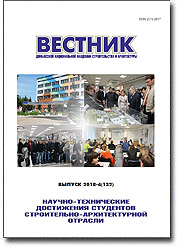Features of Formation of Ecological Skeletons of Industrial Cities
Abstract: The ecological component significantly affects the quality of life in cities, especially industrial ones. In the conditions of intensive production and imperfect legislation, in the presence of intensive emissions of harmful substances, it is necessary to carry out certain measures that can improve the ecological component of the urban environment and the quality of life of the population. Creating an enabling environment for human life in a rational use of natural resources makes it necessary to formulate the basic principles and approaches to creating an integrated spatial system of the urban ecological framework. The solution can be various urban planning activities, one of which is the creation or improvement of the ecological framework of the city. Unfortunately, in the existing urban development, the full implementation of urban planning activities is not possible, and when they are implemented, a number of problems are revealed, such as: a high density of construction, which will not allow the organization of parks or public gardens, a small number of water bodies and existing green spaces, enterprises, which can not be transferred beyond the borders of the city, the presence of territories that maximally affect the environment, such as waste heaps, dumps, which require a special approach to their solution. In this paper, we consider the features of creating an ecological framework, and its formation in the old industrial city. The foreign experience of creation of ecological skeletons is analyzed. A number of problems have been formulated that need to be resolved to justify environmentally sound methods of creating and reconstructing urban territorial and functional structures based on a landscape approach to the processes of formation of territorial systems of old industrial cities. In the urban development of the old industrial city, such methods can be: consolidation of existing green spaces; gardening of protective zones of reservoirs, ravine-girder systems, waste heaps, dumps; gardening of security zones of industrial enterprises; gardening of roofs or facades of buildings and structures. In each specific region, city or district, the methods of modernization of ecological skeletons will be individual, depending on the circumstances, for example, geographic and urban features, as well as the availability of additional structures and institutions that can positively influence the situation, for example, the presence of large parks, reserves, botanical gardens. But, nevertheless, they will also have common directions for solving the environmental problems that have arisen: carrying out various urban development measures to change the development, increasing the number of green spaces, reducing emissions by industrial enterprises, options for their conversion or removal outside the residential areas, and creation of park areas.
Keywords: ecological framework, industrial region, ecology.
Pages: 68-72.
For citation:
For citation: Lobov, M. I.; Gojenko, A. I. Features of Formation of Ecological Skeletons of Industrial Cities. – Text : electronic. – In: <em>Proceeding of the Donbas National Academy of Civil Engineering and Architecture</em>. – 2018. – Issue 2018-4(132) Scientific and technical achievements of students of the construction and architectural industry, volume 1, 2. – Р. 68-72. – URL: https://donnasa.ru/publish_house/journals/vestnik/2018/2018-4(132)_t1/st_14_lobov_gozhenko_tom_1.pdf (date of access: 20.05.2025). – ISSN 2519-2817.

Issue 2018-4 (132)
Journal: Proceeding of the Donbas National Academy of Civil Engineering and Architecture
Publish house: Donbas National Academy of Civil Engineering and Architecture
Journal: Proceeding of the Donbas National Academy of Civil Engineering and Architecture
Publish house: Donbas National Academy of Civil Engineering and Architecture
